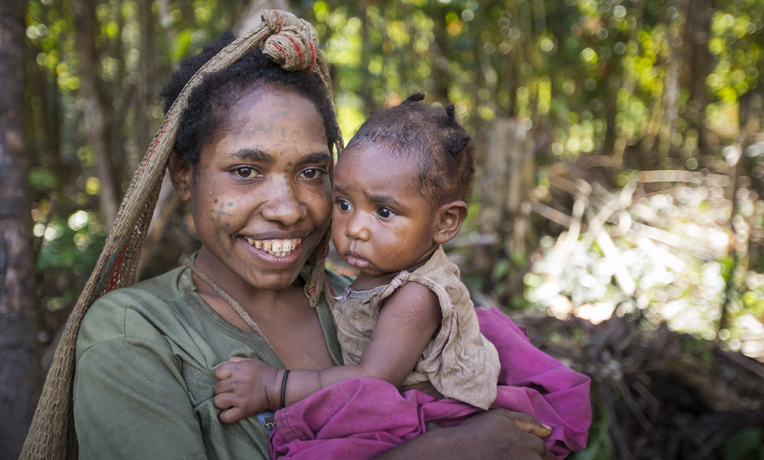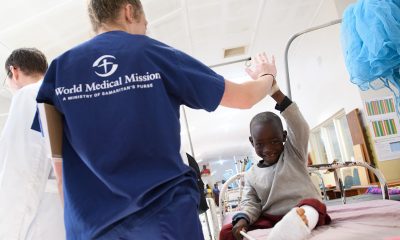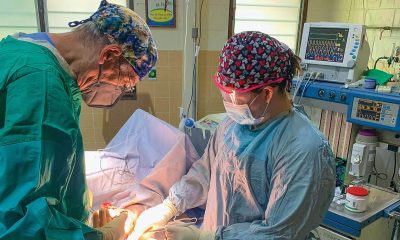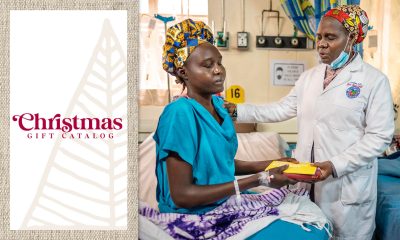A medical team goes on a rescue mission to save lives and share the Gospel among the forgotten Hewa people in Papua New Guinea
Isolated in the rugged highlands of Papua New Guinea, the Hewa people live in small clans, scattered over an 1800 square mile region of Enga Province.
A lack of medical care, coupled with a fear of evil spirits entering mothers and newborns during childbirth, has led to unsafe birthing and childcare practices that contribute to the death of 85 percent of children within the first three months of life.
Watch the trailer below, or view the short film at our Healing for Hewa page.
The cries of mothers mourning for their children echoed through the forests and touched the hearts of medical missionaries serving at Kudjip Nazarene Hospital, more than 150 miles away.
Dr. Allan Sawyer, a Christian obstetrician and gynecologist from Glendale, Arizona, heard about the plight of the Hewa people when he was serving as a short-term volunteer at the hospital. He and a small group of medical and missionary pioneers banded together with a prayer and began planning a visit to the remote tribe.
“I remember multiple occasions of hearing Franklin Graham speak about how medicine opens doors for the Gospel that otherwise would be closed,” Dr. Sawyer said as they prepared for the trip. “I am eager to see what God will do.”
IN PHOTOS: See photos from Dr. Sawyer’s trip to minister to the HewaJonathan and Susan Kopf, a missionary couple serving with New Tribes Mission, have been living among the Hewa people for more than 12 years. Susan is also a trained nurse. They paved the way for the medical team to fly by helicopter to the village of Yifki and lead a five-day Community Based Health Care and Village Childbirth Attendant course.
Drs. Rebecca Morsch and Stephanie Doenges, two medical missionaries who serve at Kudjip Nazarine Hospital, were deeply concerned about the staggering infant mortality rate among the Hewa. Dr. Morsch directs the Community Health Care Program at the hospital and Dr. Doenges oversees the maternity ward and nursery.
“Most of the deaths have to do with cultural practices,” Dr. Doenges said. “For example, the tribe believes that if anyone touches the child before the placenta is delivered, evil spirits will enter the child and mother. This means that babies often lay cold and unassisted on the dirty floor among the pigs for hours, even if the umbilical cord is around the child’s neck. Other harmful practices include using dirty, rusty blades to cut umbilical cords, and making 21 superficial cuts on the abdomens of one-month-olds to prevent swollen bellies.”
 News of the medical team coming to Yifki spread. On the first day, more than 50 people from five villages made their way along jungle paths to attend the classes.
News of the medical team coming to Yifki spread. On the first day, more than 50 people from five villages made their way along jungle paths to attend the classes.
“On one side of our open air classroom we had most of the women and children,” Dr. Sawyer said. “On the opposite side of the classroom were the men and young boys. Even the dogs, chickens, and a young cassowary would come in and listen briefly to our teaching.”
For five days, the physicians taught the Hewa about safe childbirth practices and infant care, using life-sized baby dolls, chalkboard illustrations, and team members acting out appropriate scenes.
“The people were extremely grateful,” Dr. Sawyer said. “No doctors had ever come to help them before. The men in particular were so grateful for having been taught about childbirth and about how they could help the women in the tribe when giving birth.”
On Sunday, a worship service was held under the trees.
“A tribal believer named Faimpat was sitting next to me teaching on his Hewa translation of John 3:16,” Dr. Sawyer said. “Several other men joined in the teaching, and Jonathan Kopf chimed in in the Hewa language.”
Many visitors to the village heard the Gospel for the first time that day.
 In addition to the community health and childbirth classes, the team set up a bush clinic, treating everything from pneumonia to malaria. Dr. Sawyer even doubled as a dentist, extracting teeth from patients seated in a makeshift dental chair, made from an old office chair, bolted to a wheelbarrow.
In addition to the community health and childbirth classes, the team set up a bush clinic, treating everything from pneumonia to malaria. Dr. Sawyer even doubled as a dentist, extracting teeth from patients seated in a makeshift dental chair, made from an old office chair, bolted to a wheelbarrow.
At the end of the week, the helicopter returned to shuttle the team to a dirt airstrip where a small plane picked them up for a return flight to Mt. Hagen and Kudjip Hospital. Dr. Sawyer and the others had followed in the footsteps of the Great Physician to treat the sick, share life-saving skills with the Hewa people, and proclaim the Good News.
“I don’t think I have ever been so happy in my life,” Dr. Sawyer said.
Several weeks later, two healthy babies were born to women who had attended the childcare classes. Jonathan Kopf was encouraged by the continued interest among the Hewa in community health.
“Since the Hewa women learned the importance of monitoring the health of their unborn babies, many women from distant locations have been coming to our village so that Susan and her Hewa friend, Emiyas, can follow their progress and confirm to them the principles of safe delivery,” Jonathan said. “Emiyas gives the Gospel to each lady after the prenatal checkup. The first baby to arrive was a healthy son born to Fapiya and her husband, Konefa, on Susan’s birthday! That safe delivery sparked further excitement and conversation among the women, as they are talking about the things that will help to produce healthy babies.”





